National emblem of Turkey
Turkey has no official national emblem, but the crescent and star (Turkish: ay-yıldız "crescent-star") design from the national flag is in use as the de facto national emblem on Turkish passports, Turkish identity cards and at the diplomatic missions of Turkey.
| National Emblem of the Republic of Turkey | |
|---|---|
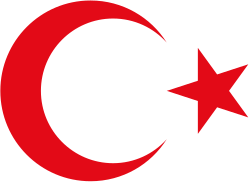 | |
| Armiger | Republic of Turkey |
| Blazon | Crescent and star |
| Use | Turkish passport, Turkish ID card, Ministry of Foreign Affairs (Turkey) |
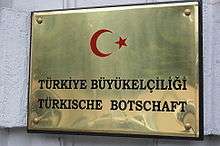
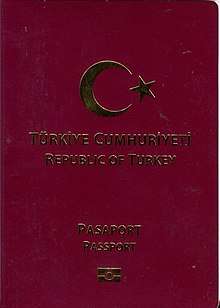
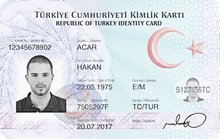
The crescent and star are from the 19th-century Ottoman flag (1844–1923) which also forms the basis of the present-day Turkish flag. Following the abolition of the Sultanate on 1 November 1922, the Ottoman coat of arms was no longer used and the crescent and star became Turkey's de facto national emblem. In the national identity cards of the 1930s the horns of the crescent were facing left, instead of the now more common orientation towards right.[1]
Use by government bodies
Red circle with white star and crescent
A circular section of the red Flag of Turkey containing the white crescent and star is used in the current emblems of a number of Turkish ministries and governmental institutions, in the emblem of the Grand National Assembly, and as the flag badge on the uniforms of Turkish national sports teams and athletes. It was also used on the old (non-digital) Turkish identity cards.[2]
 Circular flag used as a badge by the national sports teams and athletes and for other semi-official purposes
Circular flag used as a badge by the national sports teams and athletes and for other semi-official purposes.svg.png) Seal of the Grand National Assembly (parliament)
Seal of the Grand National Assembly (parliament)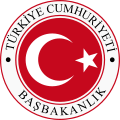 Seal of the Prime Ministry (historic)
Seal of the Prime Ministry (historic)
Gold circle with white star and crescent
Coat of arms of the Ministry of Foreign Affairs
The Turkish Ministry of Foreign Affairs often uses a red oval-shaped escutcheon which takes its colour from the Turkish flag, while its shape echoes the oval shield at the center of the late 19th-century Ottoman coat of arms.[3] The escutcheon contains a gold-tone crescent and star which are vertically oriented (with the star on top) and surrounded by the gold-tone text T.C. Dışişleri Bakanlığı.[4] A variant of this oval escutcheon (containing the gold-tone text Türkiye Cumhuriyeti Büyükelçiliği) is used by the Turkish embassies.[5][6]
 Seal of the Ministry of Foreign Affairs
Seal of the Ministry of Foreign Affairs Variant used by the Embassies
Variant used by the Embassies Variant used by the Consulates
Variant used by the Consulates
Presidential seal
The seal of the President of Turkey has a large 16-pointed star in the center, which is surrounded by 16 five-pointed stars, symbolizing the 16 Great Turkic Empires.[7] Its appearance is regulated by law.
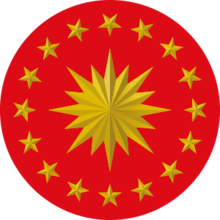 Presidential Seal of Turkey
Presidential Seal of Turkey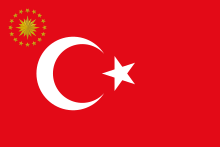 Presidential Flag of Turkey
Presidential Flag of Turkey
Proposed coat of arms
In 1925, the Ministry of National Education held a contest for a national emblem. Namık İsmail, a painter, won the contest with his coat of arms depicting Asena, a mythological wolf in the founding myth of the Gökbörü clan which ruled the Göktürk Empire. However, this coat of arms was never used.
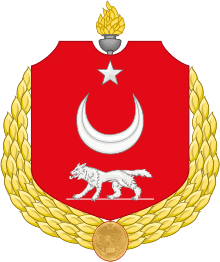 Namık İsmail's winning coat of arms (rendition)
Namık İsmail's winning coat of arms (rendition)
See also
- Coat of arms of the Ottoman Empire
- Flag of Turkey
- Turkey
- Coats of arms of Europe
References
- National ID card of Mustafa Kemal Atatürk from 1934
- Specimen of the old (non-digital) Turkish identity card
- Web site of the Ministry of Foreign Affairs of the Republic of Turkey
- Official escutcheon of the Ministry of Foreign Affairs of the Republic of Turkey
- Official escutcheon of the Turkish Embassies Archived 2013-01-26 at the Wayback Machine
- Official escutcheon of the Turkish Embassies
- Official website of the Turkish Presidency: Detailed description of the Turkish Presidential Seal